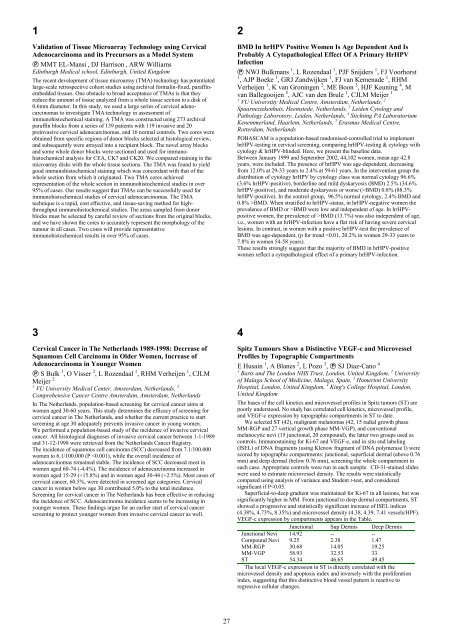2004 Summer Meeting - Amsterdam - The Pathological Society of ...
2004 Summer Meeting - Amsterdam - The Pathological Society of ...
2004 Summer Meeting - Amsterdam - The Pathological Society of ...
Create successful ePaper yourself
Turn your PDF publications into a flip-book with our unique Google optimized e-Paper software.
1<br />
Validation <strong>of</strong> Tissue Microarray Technology using Cervical<br />
Adenocarcinoma and its Precursors as a Model System<br />
MMT EL-Mansi , DJ Harrison , ARW Williams<br />
Edinburgh Medical school, Edinburgh, United Kingdom<br />
<strong>The</strong> recent development <strong>of</strong> tissue microarray (TMA) technology has potentiated<br />
large-scale retrospective cohort studies using archival formalin-fixed, paraffinembedded<br />
tissues. One obstacle to broad acceptance <strong>of</strong> TMAs is that they<br />
reduce the amount <strong>of</strong> tissue analyzed from a whole tissue section to a disk <strong>of</strong><br />
0.6mm diameter. In this study, we used a large series <strong>of</strong> cervical adenocarcinomas<br />
to investigate TMA technology in assessment <strong>of</strong><br />
immunohistochemical staining. A TMA was constructed using 273 archival<br />
paraffin blocks from a series <strong>of</strong> 139 patients with 119 invasive and 20<br />
preinvasive cervical adenocarcinomas, and 16 normal controls. Two cores were<br />
obtained from specific regions <strong>of</strong> donor blocks selected at histological review,<br />
and subsequently were arrayed into a recipient block. <strong>The</strong> novel array blocks<br />
and some whole donor blocks were sectioned and used for immunohistochemical<br />
analysis for CEA, CK7 and CK20. We compared staining in the<br />
microarray disks with the whole tissue sections. <strong>The</strong> TMA was found to yield<br />
good immunohistochemical staining which was concordant with that <strong>of</strong> the<br />
whole section from which it originated. Two TMA cores achieved<br />
representation <strong>of</strong> the whole section in immunohistochemical studies in over<br />
95% <strong>of</strong> cases. Our results suggest that TMAs can be successfully used for<br />
immunohistochemical studies <strong>of</strong> cervical adenocarcinomas. <strong>The</strong> TMA<br />
technique is a rapid, cost effective, and tissue-saving method for highthroughput<br />
immunohistochemical studies. <strong>The</strong> areas sampled from donor<br />
blocks must be selected by careful review <strong>of</strong> sections from the original blocks,<br />
and we have shown the cores to accurately represent the morphology <strong>of</strong> the<br />
tumour in all cases. Two cores will provide representative<br />
immunohistochemical results in over 95% <strong>of</strong> cases.<br />
2<br />
BMD In hrHPV Positive Women Is Age Dependent And Is<br />
Probably A Cytopathological Effect Of A Primary HrHPV<br />
Infection<br />
NWJ Bulkmans 1 , L Rozendaal 1 , PJF Snijders 1 , FJ Voorhorst<br />
1 , AJP Boeke 1 , GRJ Zandwijken 1 , FJ van Kemenade 1 , RHM<br />
Verheijen 1 , K van Groningen 2 , ME Boon 3 , HJF Keuning 4 , M<br />
van Ballegooijen 5 , AJC van den Brule 1 , CJLM Meijer 1<br />
1 VU Universtity Medical Centre, <strong>Amsterdam</strong>, Netherlands, 2<br />
Spaarneziekenhuis, Heemstede, Netherlands, 3 Leiden Cytology and<br />
Pathology Laborotory, Leiden, Netherlands, 4 Stichting PA Laboratorium<br />
Kenemmerland, Haarlem, Netherlands, 5 Erasmus Medical Centre,<br />
Rotterdam, Netherlands<br />
POBASCAM is a population-based randomised-controlled trial to implement<br />
hrHPV-testing in cervical screening, comparing hrHPV-testing & cytology with<br />
cytology & hrHPV-blinded. Here, we present the baseline data.<br />
Between January 1999 and September 2002, 44,102 women, mean age 42.8<br />
years, were included. <strong>The</strong> presence <strong>of</strong> hrHPV was age-dependent, decreasing<br />
from 12.0% at 29-33 years to 2.4% at 59-61 years. In the intervention group the<br />
distribution <strong>of</strong> cytology hrHPV by cytology class was normal cytology 96.6%<br />
(3.6% hrHPV-positive), borderline and mild dyskaryosis (BMD) 2.5% (34.6%<br />
hrHPV-positive), and moderate dyskaryosis or worse (>BMD) 0.8% (88.3%<br />
hrHPV-positive). In the control group, 96.5% normal cytology, 2.4% BMD and<br />
0.8% >BMD. When stratified to hrHPV-status, in hrHPV-negative women the<br />
prevalence <strong>of</strong> BMD or >BMD were low and independent <strong>of</strong> age. In hrHPVpositive<br />
women, the prevalence <strong>of</strong> >BMD (13.7%) was also independent <strong>of</strong> age,<br />
i.e., women with an hrHPV-infection have a flat risk <strong>of</strong> having severe cervical<br />
lesions. In contrast, in women with a positive hrHPV-test the prevalence <strong>of</strong><br />
BMD was age-dependent, (p for trend













